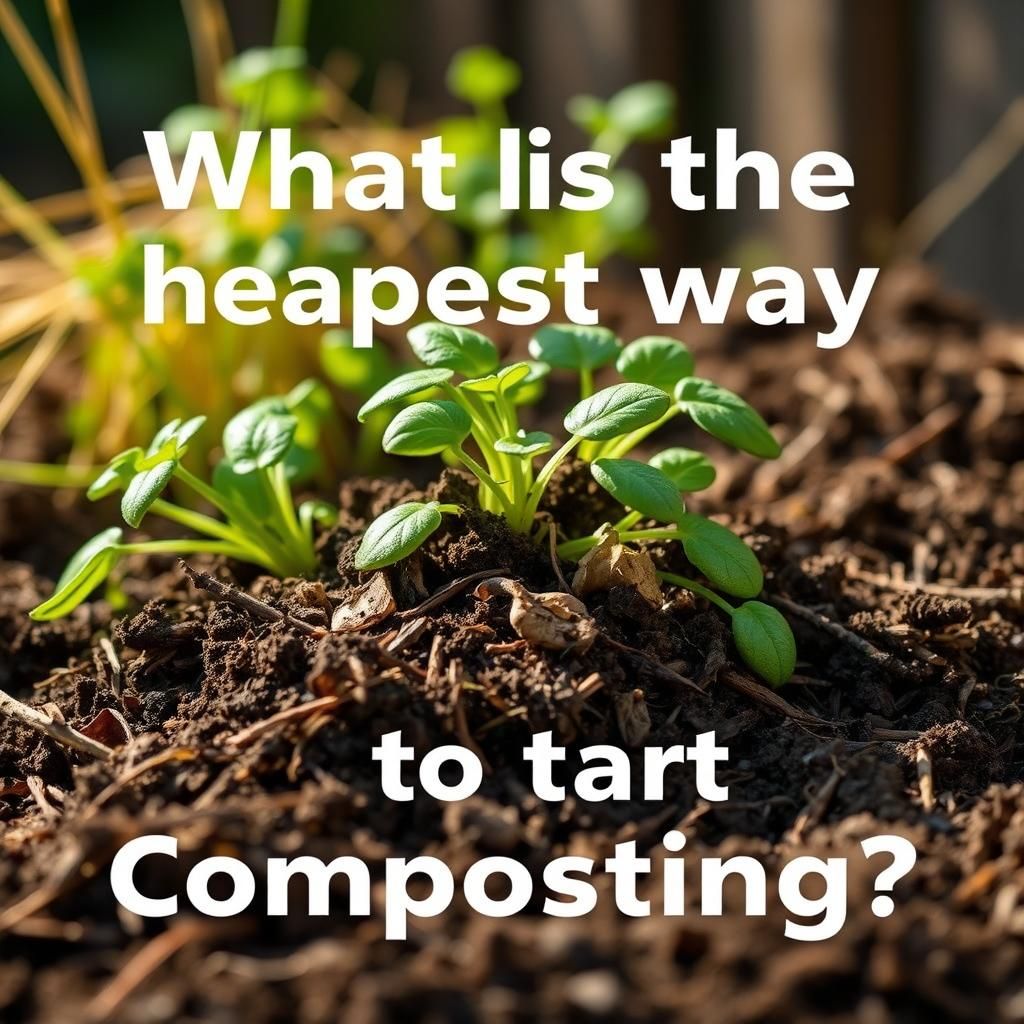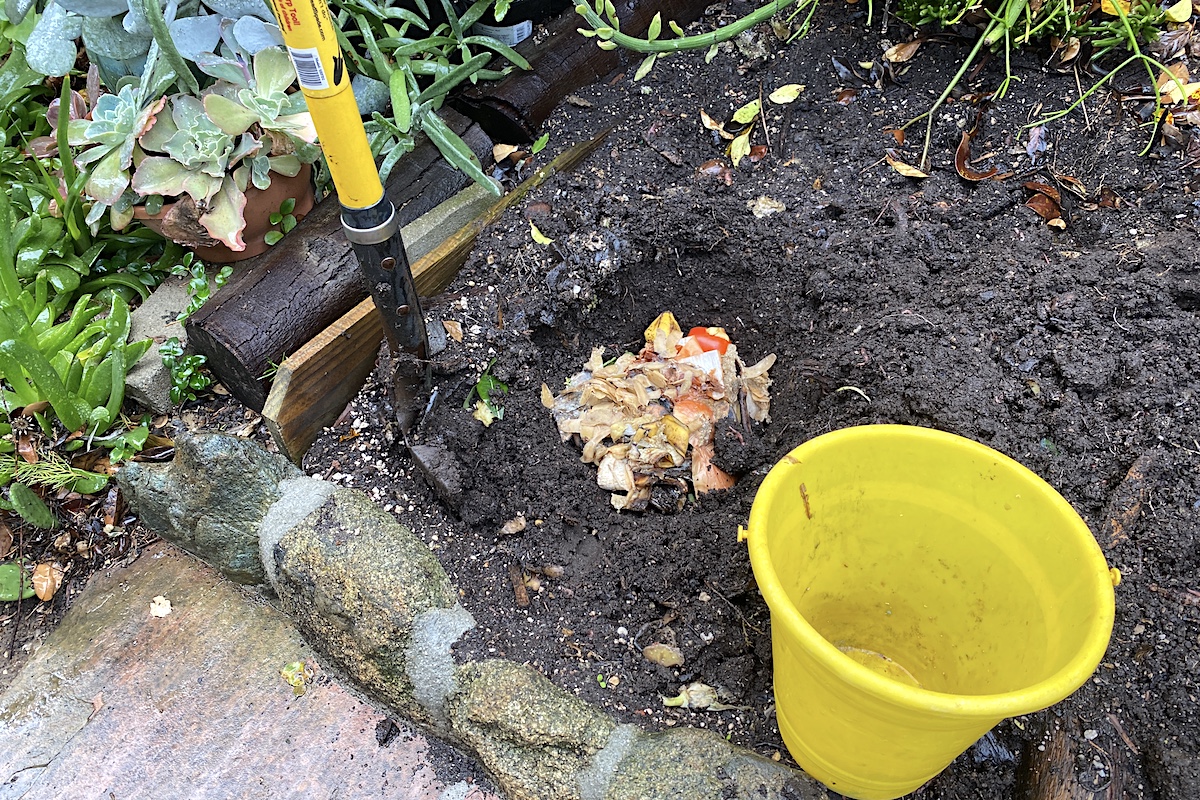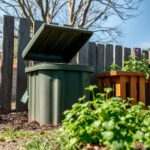What is the cheapest way to start composting? A Complete Guide to Affordable Composting Solutions

Composting is an eco-friendly practice that transforms kitchen scraps and yard waste into nutrient-rich soil, but many believe it requires a significant investment. This guide will explore the most affordable ways to start composting, proving that anyone can embrace this sustainable method without breaking the bank. From DIY compost bins to utilizing common household items, we will provide practical tips and solutions to help you kickstart your composting journey. With minimal expense, you can reduce waste, enrich your garden, and contribute to a healthier planet. Let's dive into the various cost-effective options available for aspiring composters.
What is the Cheapest Way to Start Composting?
Starting composting can be an economical and eco-friendly way to recycle organic waste, and the cheapest method involves utilizing materials you likely have at home. The basic steps to get started include finding a suitable location in your yard or on your balcony, using a simple container like a plastic bin or even a pile on the ground. Gather kitchen scraps such as vegetable peels, coffee grounds, and eggshells, along with garden waste like grass clippings and leaves. Maintain a balanced ratio of greens (nitrogen-rich materials) and browns (carbon-rich materials), aerate your compost by turning it regularly, and keep it moist but not soggy. With minimal investment and some patience, you can produce nutrient-rich compost that enhances your soil without breaking the bank.
Choosing the Right Location
When looking for the right spot to start your composting, consider an area that is accessible but also has good drainage and sunlight. A shaded area can prevent the compost from drying out too quickly, while a well-drained spot ensures excess moisture doesn’t stagnate. It's best to avoid completely sandy or wet locations since they can impact the composting process. If space is limited, consider using a small compost bin that can fit your balcony or patio.
Materials Needed for Composting
To begin composting cheaply, you'll primarily need organic materials. Kitchen scraps such as fruit and vegetable peels, coffee grounds, and stale bread make excellent greens, while shredded paper, cardboard, and dried leaves serve as browns. You can collect these materials over time, making it a cost-effective solution. It’s essential to avoid meat, dairy, and oily foods, which can attract pests. Utilizing what you already have minimizes costs and encourages recycling.
Building Your Compost Bin
You don’t have to invest in expensive compost bins; simple DIY compost bins can be made from pallets, wire mesh, or even old rubber bins that can be adapted for composting. Look for instructions online for creating a cheap, effective bin. Ensure that the bin has adequate airflow to support aerobic decomposition, which is visualized through holes or slats. This method is both cost-effective and environmentally friendly, utilizing materials that would otherwise go to waste.
Maintaining Your Compost
Maintaining your compost pile is a key factor in its efficiency and cost-effectiveness. Regularly turning the compost helps aerate the materials and speeds up the decomposition process. Keep an eye on the moisture level; if it feels dry, add water or more greens to maintain humidity. If it’s too wet, add more browns to balance it out. Monitoring these elements will help you produce high-quality compost without additional expenses for additives.
Using Your Finished Compost
Once your compost has matured, typically within a few months, it can be a fantastic resource for your garden. Use it to enrich flower beds, vegetable gardens, or houseplants, thus reducing the need for commercial fertilizers, ultimately saving you money. The nutrients in your homemade compost can significantly improve soil quality and support plant health. When you do this, you not only save money but also contribute to a more sustainable eco-system.
| Materials | Type |
|---|---|
| Vegetable Scraps | Green |
| Fruit Peels | Green |
| Shredded Newspaper | Brown |
| Cardboard | Brown |
| Grass Clippings | Green |
What is the cheapest method of composting?

The cheapest method of composting is often considered to be backyard composting, which requires minimal investment. This process involves collecting organic waste materials, such as kitchen scraps and yard debris, and allowing them to decompose naturally over time. With little to no cost involved in purchasing equipment, this method is highly accessible for most households.
What Materials Can Be Compostable?
When opting for backyard composting, it’s crucial to know which materials can effectively break down and contribute to nutrient-rich compost. Common compostable items include:
- Kitchen Scraps: Vegetable peels, coffee grounds, eggshells, and fruit waste.
- Yard Waste: Grass clippings, leaves, and small branches.
- Paper Products: Shredded newspaper, cardboard, and paper towels (avoid those with chemicals).
Basic Setup for Backyard Composting
Setting up a compost pile can be done with minimal tools and effort. Follow these simple steps to create an effective composting area:
- Location: Choose a dry, shaded spot in your yard with good drainage.
- Container: Use a compost bin, or make a simple pile, depending on preference.
- Layering: Alternate layers of green materials (like food scraps) and brown materials (like leaves) for aeration.
Maintenance of the Compost Pile
Maintaining your compost pile is essential for ensuring efficient decomposition. Here’s how to manage it effectively:
- Turning: Regularly mix or turn the pile every few weeks to aerate and speed up the process.
- Moisture: Ensure the pile remains moist but not overly wet; add water if it becomes too dry.
- Temperature: Monitor the temperature; a hot center indicates healthy activity in the compost.
Common Challenges in Backyard Composting
While it’s economical, backyard composting can present some challenges. Recognizing these can help troubleshoot issues:
See also:
- Odor Issues: Bad smells can arise from an imbalance of materials; add more browns or aerate the pile.
- Pest Problems: Rodents or insects can be attracted to food scraps; use a closed compost bin if possible.
- Slow Decomposition: This may occur due to too few greens; maintain a proper ratio of greens to browns.
Alternative Low-Cost Composting Methods
Aside from backyard composting, there are several alternative low-cost methods that can also be effective:
- Bokashi Composting: A fermentation process that utilizes bran inoculated with beneficial microbes.
- Tumbler Composting: A rotating drum that allows for easier mixing and faster decomposition.
- Vermicomposting: Using worms to break down kitchen scraps in a contained environment, ideal for smaller spaces.
How to start composting for free?

To start composting for free, you can utilize materials that are easily available in your home and community, making the process not only eco-friendly but also cost-effective. Here’s a detailed guide on how to begin your composting journey without spending money.
Gathering Composting Materials
Collecting the right materials is essential for successful composting. You can use kitchen scraps and yard waste available at no cost.
- Kitchen Scraps: Collect fruit and vegetable peels, coffee grounds, eggshells, and leftover food that can decompose.
- Yard Waste: Gather grass clippings, dry leaves, small branches, and flowers.
- Avoid: Do not add meat, dairy, or oils, as these can create odors and attract pests.
Choosing a Composting Method
There are various composting methods to choose from, and some can be set up with minimal resources.
- Pile Method: Simply create a heap of organic materials in a corner of your yard.
- Bin Method: Repurpose old pallets or bins to create a structure for better airflow.
- Container Method: Use a large bucket or trash can with holes for ventilation to make a compost container.
Maintaining Your Compost
Proper maintenance is key to speeding up the composting process.
- Aeration: Turn your compost pile or stir it to introduce oxygen, which helps decomposition.
- Moisture Control: Keep the compost moist, akin to a damp sponge, adding water as necessary.
- Balance Green and Brown Materials: Ensure a mix of nitrogen-rich (green) and carbon-rich (brown) materials for optimal compost health.
Using Free Resources
Leverage free resources available within your community to learn and improve your composting skills.
- Local Workshops: Attend free composting workshops offered by gardening clubs or community centers.
- Online Resources: Utilize websites and forums dedicated to composting for tips and advice.
- Community Programs: Join community gardening programs where composting techniques are shared among members.
Utilizing Finished Compost
After several weeks to months, your compost will be ready for use.
- Soil Enrichment: Use finished compost to enrich your garden soil, enhancing its nutrient profile.
- Mulching: Spread it around the base of plants as a natural mulch to retain moisture and suppress weeds.
- Container Plants: Mix it with potting soil for container gardening to promote healthier plant growth.
Do countertop compost machines really work?

Countertop compost machines, also known as kitchen composters, have gained popularity as a convenient way to manage food waste in households. They offer a compact and often odorless solution for composting kitchen scraps right within the home. But do they really work as effectively as traditional composting methods?
Generally, these machines do function to some extent; however, their efficiency and effectiveness can vary based on several factors, including the model, technology used, and user practices. Most countertop composters employ methods such as aerobic digestion, thermal decomposition, or microbial acceleration to break down organic matter. While these machines can significantly reduce the volume of waste, they may not produce mature compost ready for gardening as quickly or as effectively as outdoor composting systems.
How Do Countertop Compost Machines Function?
Countertop compost machines typically utilize one of several methods to process organic waste. Understanding how they function can illuminate their effectiveness.
- Aerobic methods: These machines rely on air circulation to break down food scraps with the help of aerobic microorganisms.
- Thermal digestion: Some models heat up the waste to promote rapid decomposition, accelerating the composting process.
- Microbial technology: Certain machines introduce specific strains of microbes that break down materials more efficiently than natural decomposition.
Benefits of Using Countertop Compost Machines
There are numerous advantages to using countertop compost machines that appeal to consumers seeking sustainable waste management solutions.
See also:
- Convenience: These machines are easy to use and can fit on kitchen countertops, making composting accessible.
- Odor control: Many models are designed to minimize unpleasant smells associated with decomposing food.
- Speed of processing: Some countertop composters can quickly reduce waste volume, meaning less garbage for landfills and more nutrients for gardening.
Limitations of Countertop Compost Machines
While countertop composters offer various benefits, they also have inherent limitations that users should consider.
- Space limitations: These machines typically have a small capacity and need frequent emptying, which may not suit larger households.
- End product quality: Some machines produce a nutrient-rich slurry rather than finished compost, which may require further processing.
- Initial cost: The purchase price of these machines can be significant compared to traditional composting methods.
Tips for Effective Use of Countertop Compost Machines
To maximize the efficiency of countertop compost machines, users can adopt specific strategies to enhance performance.
- Balance materials: A good mix of green (nitrogen-rich) and brown (carbon-rich) materials will improve the composting process.
- Regular maintenance: Clean the machine regularly to prevent mold buildup and ensure optimal functioning.
- Follow guidelines: Adhere to manufacturer instructions regarding what types of waste can be processed for best results.
Comparison with Traditional Composting Methods
Countertop compost machines provide an alternative to traditional composting techniques, each with its unique merits and challenges.
- Speed: Countertop composters often process waste quicker than traditional outdoor compost piles, which can take months.
- Space requirements: Traditional composting requires more outdoor space, while countertop machines can fit in even small kitchens.
- Skill level: Outdoor composting may require more knowledge about compost layers and maintenance, making countertop options more beginner-friendly.
What is the lazy way to compost?

The lazy way to compost is a method that requires minimal effort and time, making it accessible for those who want to reduce waste without investing too much energy into the process. This approach often involves using simple techniques that allow organic materials to break down naturally over time without the need for turning, aerating, or maintaining traditional compost piles.
What is Lazy Composting?
Lazy composting, also known as no-turn composting, is a straightforward approach to composting that lets organic matter decompose naturally. It typically involves placing kitchen scraps and yard waste in a designated area and allowing them to break down without much intervention. This method is ideal for those who want to recycle their waste without the commitment of regular maintenance.
Benefits of Lazy Composting
Lazy composting offers several benefits that can make it appealing for busy individuals or those new to composting. Some of these advantages include:
- Time-saving: Requires less daily or weekly commitment.
- Low effort: Minimal physical labor compared to traditional composting.
- Easier for beginners: No complicated methods or tools are necessary.
Materials Suitable for Lazy Composting
When it comes to materials for lazy composting, certain organic items perform better than others. The following materials can contribute effectively to your lazy compost pile:
- Fruit and vegetable scraps: Such as peels and cores.
- Coffee grounds and filters: Rich in nitrogen and break down easily.
- Yard waste: Like fallen leaves and grass clippings.
Where to Create Your Lazy Compost Area
Choosing the right location for your lazy compost is crucial for success. Ideal spots for lazy composting include:
- In the backyard: A secluded area where it won't disturb your garden.
- Under a tree: Provides shade and helps regulate moisture.
- Near the kitchen: Easy access for disposing of organic scraps.
How to Maintain Lazy Compost
Maintaining your lazy compost doesn’t require much, but there are a few basic practices you can follow:
- Layering: Alternate wet and dry materials to speed up decomposition.
- Moisture check: Ensure the compost stays damp but not soggy.
- Patience: Allow time for the materials to break down; it may take several months.
Tips for Successful Lazy Composting
To enhance the effectiveness of your lazy composting efforts, consider these simple tips:
- Chop up large items: This helps speed up the decomposition process.
- Avoid meat and dairy: These can attract pests and create odors.
- Use a compost bin: If you prefer tidiness and animal protection.
Questions from Our Readers
What materials do I need to start composting cheaply?
Starting composting on a budget requires minimal materials. You can use a simple plastic bin, a wire mesh, or even a pile in your backyard. Gather kitchen scraps like fruit peels, vegetable waste, and coffee grounds, along with yard waste such as grass clippings and leaves. This combination will help you create nutrient-rich compost without spending much money.
Can I compost without a bin?
Yes, you can definitely compost without a bin. Just create a designated area in your garden where you can pile your organic waste. Ensure it's a well-drained spot to prevent odors and pests. As your compost pile grows, turn it regularly to facilitate the decomposition process, and you’ll have rich compost in no time.
See also:
Is store-bought compost necessary for starting my compost?
No, you do not need to purchase store-bought compost to get started. You can begin with just your kitchen scraps and yard waste. If you want to jumpstart the process, adding a small amount of a completed compost or store-bought compost can help introduce beneficial microorganisms, but it is not a requirement.
How long does it take to start seeing results from my compost?
The time it takes to see results from composting can vary, but generally, you can expect to have usable compost within 3 to 6 months. Factors such as the materials used, moisture levels, and how often you turn the pile will influence the speed of decomposition. With good maintenance, you may be able to produce compost more quickly.

If you want to read more articles like What is the cheapest way to start composting? A Complete Guide to Affordable Composting Solutions, we recommend you check out our Compost category.
Leave a Reply
Related Articles